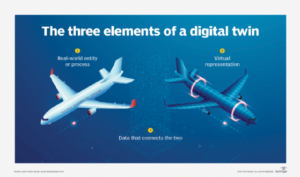A digital twin is a virtual representation of a physical object or system, created using real-time data and simulation technology. It can be used to model and monitor the performance of the physical object or system, and to predict and optimize its behavior. Digital twins are used in a variety of industries, such as manufacturing, transportation, and healthcare, to improve efficiency, reduce costs, and enhance the customer experience.

How digital twin helpful
Digital twins can be helpful in a variety of ways, such as:
- Improving efficiency: Digital twins can be used to simulate the performance of a physical system, such as a manufacturing process or a transportation network, and identify inefficiencies or bottlenecks. This can help to optimize the system and improve overall efficiency.
- Reducing costs: Digital twins can be used to predict and prevent equipment failures or downtime, which can help to reduce maintenance costs and increase uptime.
- Enhancing the customer experience: Digital twins can be used to simulate and optimize the performance of products and services, which can help to enhance the customer experience and increase customer satisfaction.
- Predictive Maintenance: Digital twin can be used to predict when a machine or equipment will fail, allowing the company to schedule maintenance and repairs before the equipment actually fails, reducing downtime and improving efficiency.
- Smart City Planning: Digital twin can be used to simulate and optimize the performance of a city’s infrastructure, such as transportation networks, energy systems, and public services.
- Training and education: Digital twin can be used as a training tool, allowing people to practice and learn in a virtual environment before working with the actual physical system.

Current research with digital twins
There are currently a variety of research projects being conducted on digital twins across a range of industries and applications. Some examples include:
- Healthcare: Researchers are using digital twins to model and simulate the human body, in order to improve the understanding of diseases, optimize treatment plans, and develop new drugs.
- Manufacturing: Researchers are using digital twins to optimize the design and performance of manufacturing systems, such as robots, assembly lines, and 3D printers.
- Smart Cities: Researchers are using digital twins to model and simulate the performance of smart cities, in order to optimize the use of resources, improve transportation, and enhance the quality of life for citizens.
- Construction: Researchers are using digital twin to optimize the construction process, by simulating the behavior of building systems, such as HVAC and electrical systems, and to identify potential issues before they occur.
- Autonomous vehicles: Researchers are using digital twin to simulate and optimize the behavior of autonomous vehicles, such as self-driving cars, drones and robots, to improve safety and performance.
- Energy: Researchers are using digital twin to model and simulate the performance of energy systems, such as wind turbines, solar panels, and battery storage, to optimize their performance and reduce costs.
- Cyber-physical systems: Researchers are using digital twin to model and simulate the performance of cyber-physical systems, such as IoT devices, sensor networks, and industrial control systems, to improve security and reliability.
Overall, the research on a digital twins is actively ongoing, as more and more industries are discovering the benefits and potential of this technology.

